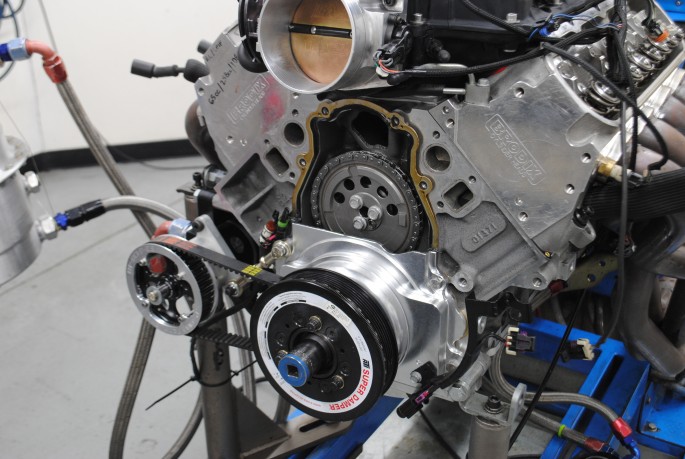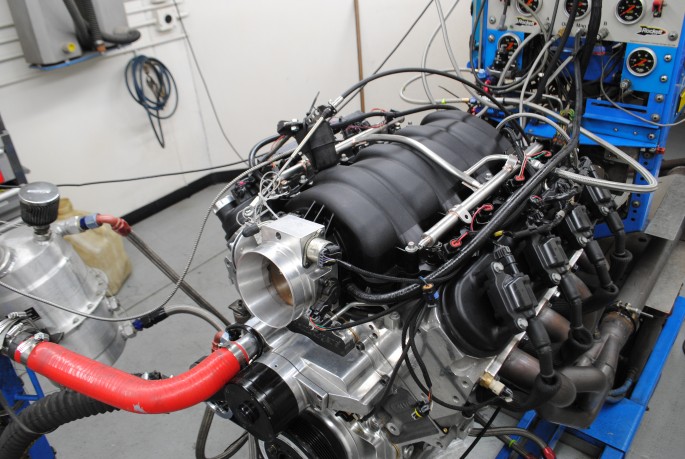Top dog in the normally aspirated LS engine family, the 427-inch LS7 is an impressive performer. Forget all the 427 big blocks of yesteryear, the modern small-block version offers both more powerful and (considerably) less weight than those hefty behemoths of yesteryear. Time and technology have indeed marched on, as the LS7 is not only able to offer more power and less weight, but also sneak under the all-important emissions radar while simultaneously managing decent fuel mileage. The LS7 really is a modern marvel, but as good as it is in stock trim, they are even better once modified. Like the rest of the LS family, the LS7 takes very well to modifications like cam profiles and (in our case) intake manifolds. This is especially true of modified LS7s like our test motor from Cool Machine Performance (CMP). They were kind enough to allow us to jump in and run the new MSD Atomic Airforce LS7 intake while they were on the dyno at Westech Performance testing some top-secret LS7 cam profiles.
The LS7 test motor started out life as a simple LS3. The aluminum block received Darton sleeves that allowed a complete Manley stroker assembly that included 4.130-bore flat-top pistons, H-beam rods and Platinum-series (4.0-inch) stroker crank. Sealing the pistons was a Total Seal ring package. The custom LS7 cam featured .644 lift, a 246/254-degree duration split (at .050) and was teamed with an adjustable cam sprocket and Aviad dry sump oiling system.

To ensure plenty of power, the modified LS7 was configured with a custom CMP cam profile that offered .644 lift, a 246/254-degree duration split and 112-degree lsa.

The modified LS7 featured a sleeved block combined with a Manley forged rotating assembly all topped off with a set of CMP Brodix SI LS7 heads. Starting with a Brodix LS7 casting, the heads were treated to proprietary port designs that both increased flow and reduced port volume (always a good combination). Note also the ATI damper, Aviad dry sump system and polished, two-piece timing cover that provided access to the adjustable cam gear.
Topping the big-bore LS7 was a set of CNC-ported, CMP Brodix SI LS7 heads. These custom LS7 casting offered 258-cc intake ports, 108-cc exhaust ports and 62.5-cc combustion chambers. Head flow peaked at just over 395 cfm on the intake and 259 cfm on the exhaust, allowing them to support over 800 hp on the right application. This modified LS7 was run on the dyno with Lucas synthetic oil, a Holley Dominator management system and Kooks long-tube headers. Also present on the impressive stroker was an ATI damper, Meziere electric water pump and Fast 102-mm throttle body.

The intake test was run through a set of Kooks 1 7/8-inch, long-tube headers feeding a 3-inch exhaust with Magnaflow mufflers.

On hand to dial in the air/fuel and timing curves was a Holley Dominator EFI system. Equipped with the stock LS7 intake, the modified LS7 produced 642 hp at 6,800 rpm and 554 lb-ft of torque at 5,400 rpm.
The first order of business was to run the stock LS7 intake. After installation of the manifold, the modified LS7 was run in anger to the tune of 642 hp at 6,800 rpm and 554 lb-ft of torque at 5,400 rpm. The Holley Dominator allowed us to dial in the air/fuel and timing curves to maximize power production. The torque peak topped 550 lb-ft briefly but the LS7 managed to exceed 500 lb-ft from 3,400 rpm to 6,700 rpm. After confirming the baseline, off came the stock manifold and on went the MSD Atomic Airforce LS7 intake. Installation of the MSD required use of a factory LS3 fuel rail, but the results were more than worth the extra effort. Equipped with the MSD Atomic intake, the LS7 pumped out 684 hp at 6,900 rpm and 586 lb-ft at 5,100 rpm. We love when intake manifold produce gains of over 40 hp but especially when those gains come with improvements through the entire rev range. While some intake swaps will trade low-speed torque for top-end power, the Atomic intake literally force fed the LS7 and improved the power everywhere.

Next came the MSD Atomic Airforce LS7 intake. The MSD intake bolted in place easily using a factory LS3 fuel rail.

After installation of the MSD intake, the peak numbers jumped by more than 40 hp and 30 lb-ft of torque to 684 hp and 586 lb-ft of torque.
All we can say is WOW! LS7 motors are impressive even in stock trim, but this modified LS7 from CMP was even more so. Thanks to a slight over bore, this modified motor was sporting a hair over 430 inches, but the custom cam and proprietary CMP Brodix SI LS7 heads were the real power players. Run with the stock LS7 intake, the modified LS7 produced 642 hp at 6,800 rpm and 554 lb-ft of torque at 5,400 rpm. After installation of the MSD Atomic intake, the peak numbers jumped to 684 hp at 6,900 rpm and 586 lb-ft at 5,100 rpm. The Airforce intake not only improved the peak numbers but offered significant gains through the entire rev range, even below 3,500 rpm. More peak power is always good but more power everywhere is even better.
Sources:
Brodix
479-394-1075
CMP
818-427-3016
Holley/Hooker
270 782-2900 (Tel)
Lucas Oil
MSD
915 857-5200





























Atomic Airforce?
Does that mean it vapourises this hunk of Chevy shit into smelly little particles?
Love it or hate it, the LS is still a solid motor that makes good HP and can be worked on. It really is the motor that helped kickstart today’s horsepower wars. All of today’s top performing V8s on the USDM: third-gen Hemis, the Coyotes and new 5.0s, the 2UR-FE, all of them were responses to the huge uptick of power the LS ignited in the early-oughts.
This swanky Atomic manifold is very apropos: just as the LS really changed the direction of V8s, the Atomic systems are really reshaping the bolt-on EFI landscape, too.
Since the 4.6 Ford in the DOHC configuration was introduced in 1993 in the Mark VIII and the Mustang Cobra in 1996 and the 1st LS1 was introduced in the Corvette in 1997, I would have to say that it is the other way around. The LS series followed the Ford modular program.
Technically, you’re 100% correct, the Ford Modular Engine Family rolled out earlier, but they really offered lukewarm performance until the 3-and-4 valve per cylinder engines debuted.
Regardless, the Mod Blocks are actually a bigger achievement since they ushered in an era of standardized design and components for Ford, as well a first attempt to really embrace modern metallurgy, EFI and emissions equipment.
Respectfully,
The Mark VIII and the Cobra 4.6 were 4 valves per cylinder, hence the term dohc.
The garden variety 4.6- 2 valve was a sohc. Nevertheless, both engines are worthy opponents.
Hate this, hate that, bla bla bla.
What is your problem ?
Is there anything you really like ?
Please think positive.
Greetings from the Netherlands !
I like Dutch footballers – Newcastle United’s Tim Krul and Gino Wijnaldum!
But I REALLY hate chevys!
Why ?
What happend ?
He probably lost too many street races to LSx engine cars – someone forgot to tell him imports can’t race uphill.. LOL